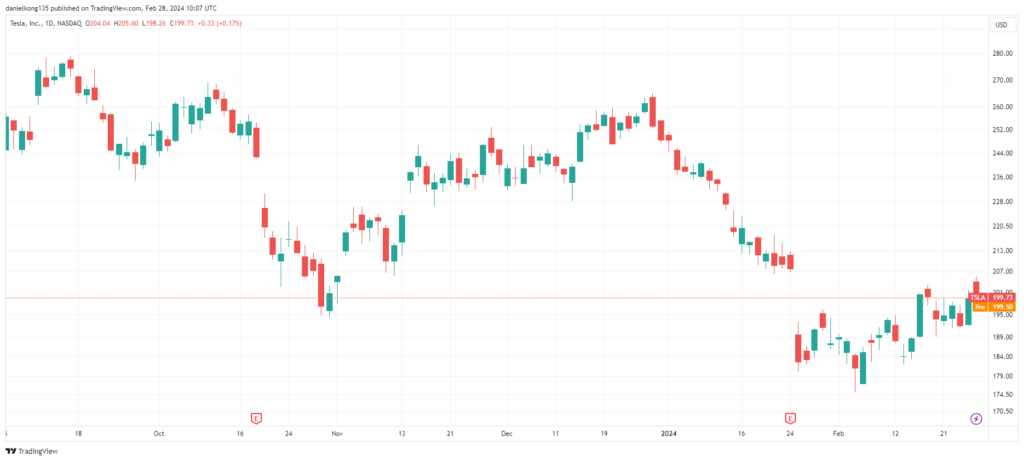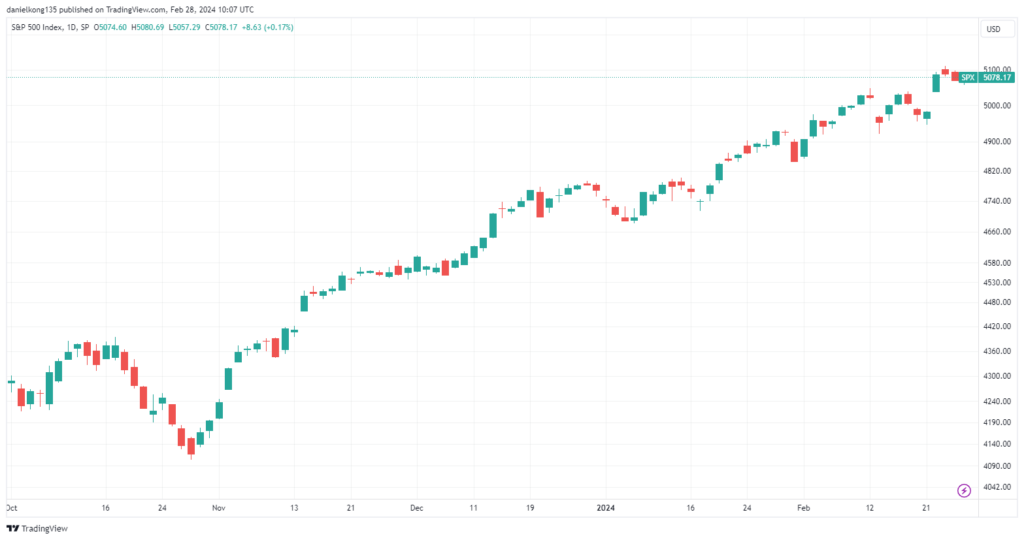In the world of trading, index trading and stock trading are popular options particularly for beginners.
Index trading involves investing in a market index such as the S&P 500 and Nasdaq 100, which represent a broad section of the market through a diversified portfolio of stocks. This method is based on the idea that selecting a winning stock that consistently beats the market is difficult, hence investing in the broader market allows you to ride the long term rise of the market. This makes it a popular option for those looking for a less active trading approach.
On the other hand, stock trading involves carefully selecting specific stocks to buy into, based on in-depth analysis, with the aim of outperforming the overall market.
Now let’s dive deeper into a comparison of these two product-centric strategies, using Tesla, a leader in the electric vehicle sector which is also a component in the S&P 500.
Key Points
- Index trading provides broad market exposure, fostering stability and long-term growth through diversification.
- Stock trading demands detailed analysis for higher potential returns, yet carries greater risk and volatility.
- Tesla’s fluctuating performance versus the S&P 500’s resilience showcases diversification’s role in risk management, emphasising the robustness of index trading over stock trading.
Understanding Index Trading and Stock Trading
Index Trading
Index trading is a straightforward approach to trading, where traders trade mutual funds or ETFs that replicate the performance of a specific market index, such as the S&P 500.
Alternatively, traders can utilise contracts for differences (CFDs), which allow you to speculate on the price movements of these indexes without needing to own the underlying asset.
The appeal of index trading lies in its straightforward nature and cost-effectiveness of gaining broad market exposure. This allows traders to capitalise on the overall growth of the economy over time without the need for meticulous stock selection or timing the market.
Interested in starting CFD trading? Open a live account with Vantage today and begin trading in indices CFDs.
Stock Trading
In contrast, stock picking is an active trading strategy that involves analysing and selecting individual stocks to trade, with the goal of achieving potential returns than the broader market.
This method requires a deeper understanding of the market, industries, and specific companies. While it offers the tantalising prospect of significant returns, it also carries a higher risk and requires more time and knowledge to execute effectively.
Case Study Analysis – Tesla in the S&P 500

In the early part of October 2023, Tesla‘s stock was on an upward trajectory, reaching a peak of $263.62 on 10 October 2023. Following this period, the stock experienced considerable volatility, mirroring the company’s responsiveness to market dynamics, regulatory updates, and advances in technology.
By January 2024, Tesla’s stock faced its most substantial decline in more than a year, plummeting 12% on 25 January [1]. This significant drop came in the wake of the company’s earnings report, which fell short of expectations. Furthermore, Tesla issued a caution regarding a potential slowdown in 2024, attributed to efforts directed towards the launch of its ‘next-generation vehicle’. Notably, Tesla’s automotive revenue for the fourth quarter of 2023 was $21.6 billion, marking a modest increase of 1% from the previous year [2].
In February 2024, Tesla’s stock traded sideways, with its price fluctuating between $180 and $200, before closing at $202.04 on 28 February 2024.
| Stock Price on Closing 2 October 2023 | Stock Price on Closing 28 February 2024 | % Changes | Profit or Loss | |
| 1 unit of Tesla stock | $251.60 | $202.04 | – 19.67 | – $49.56 |
If you’re a trader who bought 1 stock of Tesla since the start of October 2023, this would have resulted in a loss of $49.56.

Conversely, the S&P 500 index, a diversified portfolio representing the top 500 companies in the US by market capitalisation, provided a contrasting narrative of stability. On 2 October 2023, the S&P 500 index was trading at $4,288.39. Over the subsequent month, the index value was slowly trading downwards before gaining an upward momentum in November.
By 8 February 2024, the S&P 500, broke the 5,000.00 for the first time ever [3]. This marks a significant breakthrough as the stock market navigated a challenging economic environment with looming signs of economic uncertainties and geopolitical tensions throughout 2023. This was partly due to the demand for artificial intelligence that benefitted Nvidia, a tech leader known for its cutting-edge GPUs for gaming and professional use, and its breakthroughs in AI and it is also a key component in the S&P 500.
The day after the Nvidia earnings report was announced, its share price jumped from $674.72 to $785.38 on 22 February 2024. This has helped fuel the S&P 500 index to end at a record high on 22 February 2024, gaining 105.23 points or 2.11% to close at 5,087.03 [4].
| Stock Price on Closing 2 October 2023 | Stock Price on Closing 28 February 2024 | % Changes | Profit or Loss | |
| 1 unit of S&P 500 index | $4,288.39 | $5,069.76 | 18.22 | $781.37 |
If you’re a trader who bought 1 unit of S&P 500 index using CFDs since the start of October, that would have resulted in a potential earning of $781.37.
This is an example of how an individual stock like Tesla can trend downwards throughout the period, while an index like the S&P 500 index demonstrates a different outcome due to the composition of the index. In the case of the S&P 500, the decline in Tesla’s price was significantly mitigated by Nvidia’s gains. It’s important to note that as of the date of writing, Tesla makes up only 1.29% of the S&P 500 index, whereas Nvidia accounts for 4.58% of the index [5].
Indeed, one might argue that investing solely in a company like Nvidia could potentially yield higher returns than trading the index, due to its substantial gains. However, identifying which company will be the next Nvidia versus one that may follow Tesla’s downward trajectory is fraught with uncertainty and risk.
Risk vs. Reward
The debate between index and stock trading often revolves around finding a balance between risk and reward.
Trading an individual stock such as Tesla, can offer potential prospects for high returns if the stock experiences substantial growth. However, this strategy also exposes investors to higher levels of risk, as the performance of individual stocks can be highly volatile.
Unexpected developments, whether specific to the company or within the broader market, can dramatically affect a stock’s price. In contrast, index investing provides a more balanced approach, spreading risk across a diverse portfolio of stocks and typically offering more stable, albeit potentially lower, returns over the long term.
Diversification, a key principle of index trading, serves as a risk management tool against the volatility inherent in stock picking. By trading an index, traders can mitigate the impact of poor performance by any single stock, as losses can be offset by gains in other areas of the portfolio.
Conclusion
The contrast between index trading and stock trading lies in their approach to risk and potential returns, with stock trading offering high rewards at the risk of greater volatility, as illustrated by Tesla’s fluctuating stock performance.
Conversely, index trading, through diversification across a broad portfolio such as the S&P 500, presents a more stable investment option, reducing the impact of individual stock downturns. The resilience of the S&P 500, even when individual stocks like Tesla decline, highlights the advantage of index trading in spreading risk.
The choice between these trading strategies ultimately hinges on an investor’s risk tolerance and trading objectives. Open a live account today with Vantage and start trading stock CFDs and indices CFDs, with flexibility and precision.
Our platform enables you to execute trades on market movements in either direction, allowing you the flexibility to go long for potential returns in rising markets, or engage in short selling to potentially capitalise on downturn.
References
- “Tesla erases $80 bln in valuation after Musk’s sales warning – Reuters”. https://www.reuters.com/business/autos-transportation/tesla-tumbles-after-ceo-elon-musk-warns-slower-growth-2024-2024-01-25/. Accessed 28 Feb 2024.
- “Tesla shares close down 12% after automaker warns of slowdown – CNBC”. https://www.cnbc.com/2024/01/25/tesla-tsla-shares-fall-after-musks-ev-maker-warns-of-2024-slowdown.html. Accessed 28 Feb 2024 .
- “S&P 500″ Breaks 5,000 For First Time In History – Forbes”. https://www.forbes.com/sites/dereksaul/2024/02/08/sp-500-breaks-5000-for-first-time-in-history/?sh=e09397273613. Accessed 28 Feb 2024.
- “S&P 500, Dow surge to record closing highs as Nvidia sparks AI frenzy – Reuters”. https://www.reuters.com/markets/us/nasdaq-futures-jump-nearly-2-after-nvidia-trounces-expectations-2024-02-22/. Accessed 29 Feb 2024.
- “S&P 500 ETF Components – Slickcharts”. https://www.slickcharts.com/sp500. Accessed 29 Feb 2024.



